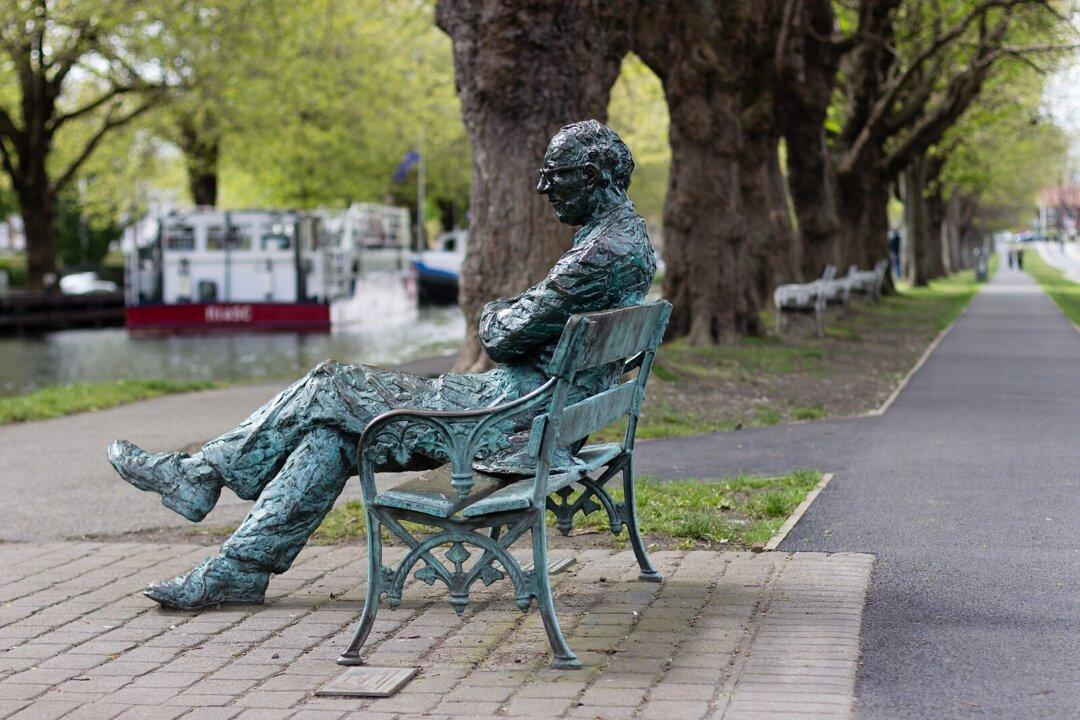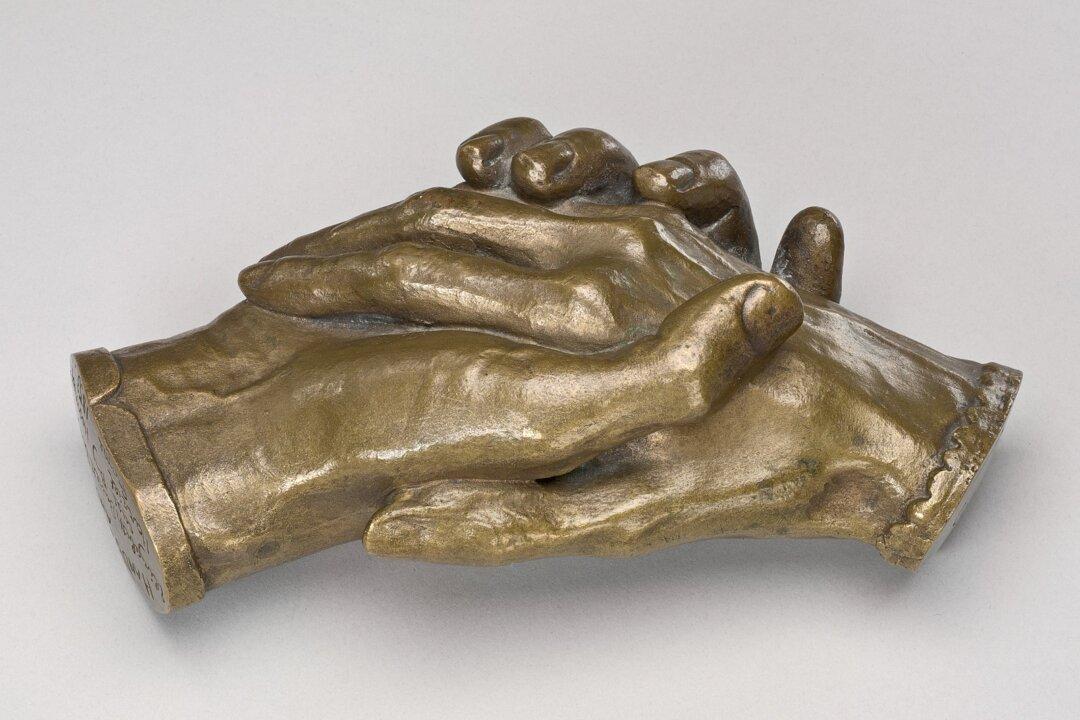In 1931, 27-year-old Patrick Kavanagh walked 50 miles to Dublin to meet with George Russell, editor of the national newspaper The Irish Statesman. As time passed, Kavanagh would become one of Ireland’s most beloved poets.
At the time though, he lived on his family’s small farm in Inniskeen and was no stranger to poverty and hardship. With little aptitude for his family’s shoemaking business, Kavanagh worked on the farm. Eventually, he began to write.
Kavanagh’s first published work was in a regional newspaper in 1928, after which, he began to attract the notice of national newspapers. Russell, initially rejecting Kavanagh’s work, encouraged him to keep writing, and eventually published some of his poems in 1929 and 1930.

Finding Nature’s Beauty
Throughout a literary career fraught with disappointments, Kavanagh struggled to win acclaim and was often derided as a “peasant poet.” In his various periods of despondence, he found renewal through engaging with nature. He began to look at the minute details of quotidian life through a lens of poetic wonder. His works evinced a dynamic receptivity to the beauty around him. This encounter with the material world enabled him to transcend it.In 1955, Kavanagh was diagnosed with cancer and had a lung removed. While recovering, he enjoyed taking walks along the banks of the Grand Canal in Dublin. During this time, he experienced a poetic rebirth, drawing inspiration from his surroundings for many of his future poems, such as “Canal Bank Walk.”

“Canal Bank Walk” shows Kavanagh to be a mystic of the commonplace, filling the reader with his own effusive enthusiasm for life. In a way, it serves as the poet’s magnificat, resounding with praise for life and creation as the poet pleads to be a vessel used to glorify God.
Leafy-with-love banks and the green waters of the canal Pouring redemption for me, that I do The will of God, wallow in the habitual, the banal, Grow with nature again as before I grew.
The bright stick trapped, the breeze adding a third Party to the couple kissing on an old seat, And a bird gathering materials for the nest for the Word Eloquently new and abandoned to its delirious beat.
O unworn world enrapture me, encapture me in a web Of fabulous grass and eternal voices by a beech, Feed the gaping need of my senses, give me ad lib To pray unselfconsciously with overflowing speech For this soul needs to be honoured with a new dress woven From green and blue things and arguments that cannot be proven.
“Canal Bank Walk” is a poem of rebirth. It overflows with the renewed appreciation of life by one who has escaped both physical and spiritual death (as shown in the word “redemption”). The speaker has a chance to “grow with nature again as before I grew.” He beholds his surroundings with new eyes, refreshed and ready to return to luxuriate in “the habitual, the banal.” The language paints a picture of a lush, verdant setting—the overflow of love from God into His creation. The poet reciprocates this love with radical surrender to God’s will, accepting his current situation in life whatever it may be.Dignity and Value
In the second stanza, we see nature, God, and mankind intertwined into one tapestry of life. A multitude of voices in nature (the stick, the breeze, and the bird building her nest) coalesce into one choir of prayer. Each of them works to bring God’s Word into the world, as though they were everyday incarnations of His love. Man participates in this rhythm, and the resulting unity infuses creation with a delirious joy.There have been many poets who find themselves world-weary later in life; even in the midst of nature’s beauty, they cannot find anything to rejuvenate them. William Cullen Bryant famously says in his poem “The Rivulet,” “I’ve tried the world—it wears no more/ The colouring of romance it wore.”
Kavanagh, recovering from cancer, soundly rebuffs this sentiment. Not only does he himself feel renewed, but everything he beholds is entirely new as well; part of the “unworn world” enraptures him as though in the throes of young love. Where Bryant feels the days of his youth are long past, Kavanagh feels a sense of his own dignity and value. He takes his place among the “eternal voices” of nature that sing their Creator’s praise. What’s more, he recognizes that his soul ought to be honored, clothed with the garment of faith and fed by beauty ever ancient and ever new.

Childlike Wonder
The speaker’s desire to “pray unselfconsciously with overflowing speech” recalls Mary’s Magnificat, a spontaneous overflow of praise to God as she says, “My soul proclaims the greatness of the Lord, my spirit rejoices in God my Savior.” Such prayer is prompted by uninhibited, childlike wonder which elevates the beholder through his very recognition that he is in the presence of something beyond himself.“Kavanagh raises to importance the most routine details of everyday life by the light of his poetic wonder. This perhaps is the sense in which Kavanagh describes the poet as a theologian. For in such moments, wonder constitutes a religious as well as an artistic state of mind, a theological as well as a poetic agenda in Kavanagh’s work. Wonder alerts Kavanagh to the sacramentality of the created world; God is close at hand in the moments that inspire and surprise.”
The poet’s receptivity to beauty in the mundane enables him to experience a sense of wonder. Without his attentiveness and appreciation for even the minute details in his everyday sphere, he would be shut off from wonder. It is through wonder that one can recognize the element of mystery in such sources of beauty, and in this mystery a person encounters God in his Creation and comes to better know him.
Kavanagh found so much to enamor him in his day-to-day life that “Canal Bank Walk” may be considered a love poem to his daily route. Recently, I heard a story about a man who moved to a new country and sent pictures back home to his family. Out of all the pictures the family received, everyone was particularly struck by a particular picture which turned out to be of the backyard. The experience caused him to look at his surroundings differently and to pay conscious attention to the overlooked beauty which everyone else had found so striking.
In a similar manner, Kavanagh’s poem prompts us not to undervalue the beauty immediately before us just because we have it so readily accessible all the time. Consciously training ourselves to become unhabituated to what is habitual, we make ourselves receptive to the many channels of grace available to us in our everyday lives.







